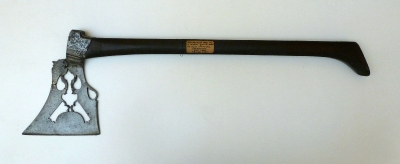To search the RPR site click here
Three ceremonial miner’s axes
1884.26.1, 2, 3
Elin Bornemann
In Pitt-Rivers’ collection, and currently on display on the Lower Gallery of the Pitt Rivers Museum, are three miner’s axes from Saxony, Germany. These are not the tools used by miners, but rather served as insignia during miners’ parades.
The first of these axes (1884.26.1) has a wooden handle inlaid with ivory decorations, with motifs including flowers and crossed swords. The largest of these inlays is a crucifix flanked by two praying figures. It is not surprising to find religious motifs, since mining was a dangerous occupation, and people felt they had to trust in the protection of God. The blade has a long upward-pointing spike, which is typical for this type of axe.
The second axe (1884.26.2) has a much plainer handle without decoration, but the blade has a much more elaborate cut-out pattern. It is of a similar shape, but the upward spike is less pronounced.
This type of axe is called ‘Bergbarte’, and while it is derived from the tool used for mining, it evolved into a ceremonial accessory during the 17th century. It was part of a miner’s parade uniform, which similarly developed from the working clothes of the miners. The Bergbarte became the parade accessory of the higher mining officials as well as the low-ranked miners. A book on the dress of miners in the Kingdom of Saxony, published in Germany in 1831, shows a Saxon miner in his parade uniform, carrying the Bergbarte over his shoulder, as well as a higher official with the rank of ‘Oberberghauptmann’, whose uniform and axe are more ornate, but basically consist of the same elements.
The third axe in Pitt-Rivers’ collection (1884.26.3) is of a different type. It has a long handle of dark wood, inlaid with mother of pearl, the end sheathed in brass. The blade is small, also of brass, with a floral decoration and a four-lobed shape cut out. This is probably an example of the type called ‘Steigerhäckchen’, although they typically also have an upward-pointing spike on the blade. The corner where it is supposed to be on Pitt-Rivers’ specimen is slightly more rounded that the opposite corner, so it is possible that the spike was originally present and broke off, and the corner was then smoothed to make it safe. The Steigerhäckchen was the insignium of the intermediate ranks in the miners’ parade. A ‘Steiger’ is still a miner, but with some supervisory responsibilities. The 1831 book shows several uniforms which include a Steigerhäckchen, for example this of a ‘Schichtmeister’ (= shift supervisor).
All three axes are described as ‘Saxon miner’s axes’ in the Accession Book. They are probably from the Erzgebirge, a region whose name literally means ‘ore mountains’. The chain of mountains is situated in the south of the German state of Saxony, running along the border with the Czech Republic. Its highest peaks are 1244 m and 1215 m. The mining industry of that region had its beginning in the 12th century with the discovery of silver, tin and copper. More and more deposits, particularly of silver, were discovered in the following centuries. The mining of these ores reached its high point in 1530. In 1542 silver was found in Potosi, Bolivia, and imports from there into Europe began to dominate the market. But the Erzgebirge also yielded iron ore, kaolin for the production of porcelain, uranium ores for the production of dyes, and tungsten. Mining contitued throughout the 18th, 19th and 20th centuries, until most sites were closed down in the 1980s and 1990s. The timeline for the history of mining in Saxony, as presented on the website of the Saxon miners’ association, terminates in 1991.
The traditions which came out of that history are alive to this day. Miners’ parades are held in several Saxon towns every year in December, and the miners still wear their parade uniforms and carry Bergbarte and Steigerhäckchen. There are a number of miners’ choirs with a repertoire of traditional miners’ songs, who perform in uniform complete with Bergbarte. Mining has dominated life in the Erzgebirge for so many centuries, and people feel strongly about their heritage and are keen to keep it alive.
Pitt-Rivers collected these three axes in the 19th century, but they reach much further back into history. The Bergbarte with the inlaid handle is dated 1675. Since ceremonial axes only developed in the 17th century, this is an early example of its kind. At the same time they connect with the present, with miners today carrying axes of exactly the same shapes. These three axes represent several centuries of unbroken tradition in the Erzgebirge mining communities.
Further reading:
G. E. Rost: Trachten der Berg- und Hüttenleute im Königreiche Sachsen: nach dem neuesten Reglement mit landschaftlichen Umgebungen aus den verschiedenen Bergamtsrevieren nach der Natur gezeichnet in Kupfer gestochen und treu colorirt. (Freiberg: 1831)
Available online here
Online catalogue entry for Bergbarte in museum in Dresden
Klemm, Gustav Friedrich: Allgemeine Kulturwissenschaft: Werkzeuge und Waffen (Leipzig: 1854), p. 121 (for Steigerhäckchen), pp. 127-128 (for Bergbarte)
August 2012




![Bergmann, from Rost [see further reading]](../../component/joomgallery/bergmann_20120830_1743789012-view=image&format=raw&type=img&id=1201&Itemid=41.jpg)
![Schichtmeister, from Rost [see further reading]](../../component/joomgallery/schichtmeister_20120830_1187305593-view=image&format=raw&type=img&id=1202&Itemid=41.jpg)
![Oberberghauptmann, from Rost [see further reading]](../../component/joomgallery/oberberghauptmann_20120830_1941237421-view=image&format=raw&type=img&id=1203&Itemid=41.jpg)


